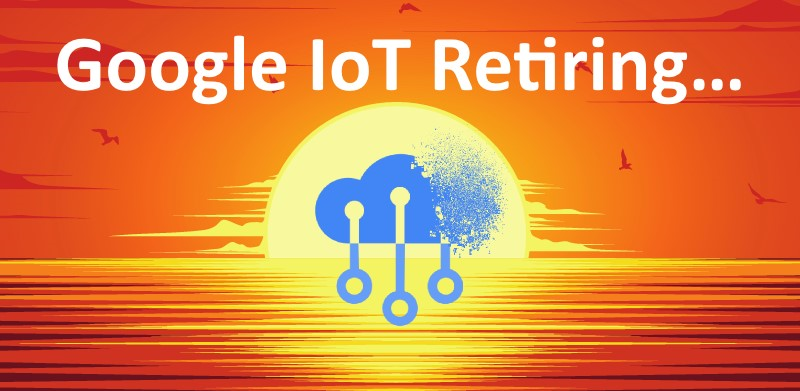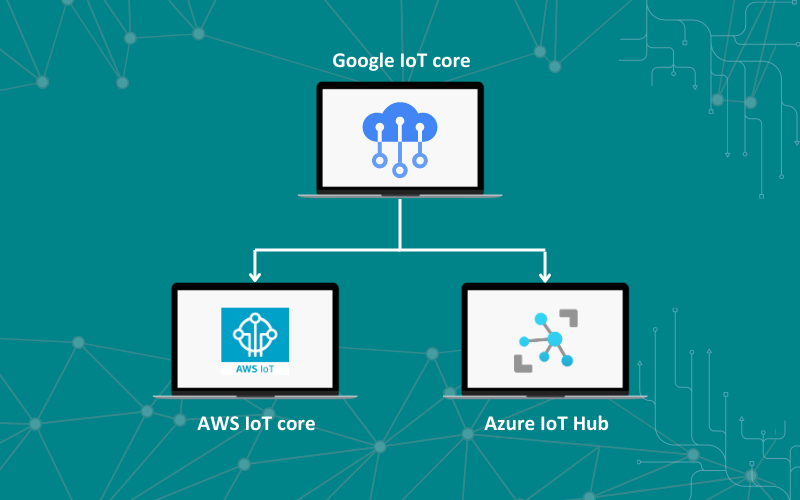
❅
❅
❅
❅
❅
❅
❅
❅
❅
❅
❅
❅
❅
❅
❅
❅
❅
❅
❅
❅
❅
❅
❅
❅
❅
❅
❅
❅
❅
❅
❅
❅
❅
❅
❅
❅
❅
❅
❅
❅
❅
❅
❅
❅
❅
❅
❅
❅
❅
❅
❅
❅
❅
❅
❅
❅
❅
❅
❅
❅
❅
❅
❅
❅
❅
❅
❅
❅
❅
❅
❅
❅
❅
❅
❅
❅
❅
❅
❅
❅
❅
❅
❅
❅
❅
❅
❅
❅
❅
❅
❅
❅
❅
❅
❅
❅
❅
❅
❅
❅
❅
❅
❅
❅
❅
❅
❅
❅
❅
❅
❅
❅
❅
❅
❅
❅
❅
❅
❅
❅
❅
❅
❅
❅
❅
❅
❅
❅
❅
❅
❅
❅
❅
❅
❅
❅
❅
❅
❅
❅
❅
❅
❅
❅
❅
❅
❅
❅
❅
❅
❅
❅
❅
❅
❅
❅
❅
❅
❅
❅
❅
❅
❅
❅
❅
❅
❅
❅
❅
❅
❅
❅
❅
❅
❅
❅
❅
❅
❅
❅
❅
❅
❅
❅
❅
❅
❅
❅
❅
❅
❅
❅
❅
❅
❅
❅
❅
❅
❅
❅
Introduction
As of August 16, 2023, Google has made an official announcement that its IoT Core service, which was introduced in 2017 as an entry into the competitive market of the Internet of Things (IoT), will be retired. After about five years in operation, Google has decided to discontinue the IoT Core service, notifying its customers in August of the previous year, leaving them with the task of finding alternative solutions. A comparison of Google's IoT portfolio with that of its direct competitors, such as Microsoft Azure or Amazon Web Services (AWS), reveals that the offerings in Azure and AWS are more extensive.
Alternatives To Google IoT Core Services
Google's current IoT core services can be substituted with comparable alternatives like AWS IoT Core or Azure IoT Hub. These services not only serve as replacements for Google's existing IoT offerings but also provide more comprehensive features. Let us discuss AWS IoT core and Azure IoT Hub along with its benefits in detail.
1. What is AWS IoT Core?
AWS IoT Core is a robust and user-friendly platform that simplifies and secures the process of connecting devices to the cloud. With IoT Core, managing and scaling device fleets becomes a seamless experience, as it eliminates the need for server provisioning or manual management. This allows businesses to focus on their core operations while ensuring a reliable and efficient connection between their devices and the cloud.
The platform offers a variety of communication protocols, enabling you to select the one that best suits your requirements. Whether it's MQTT, HTTPS, MQTT over WSS, or LoRaWAN, AWS IoT Core provides comprehensive solutions. This flexibility ensures smooth and efficient data exchange between your devices and the cloud.
Security is paramount, and AWS IoT Core takes it seriously. The service provides mutual authentication and end-to-end encryption, safeguarding your device connections and data from potential threats or unauthorized access. Rest easy knowing that your valuable information is protected at all times.
Additionally, AWS IoT Core empowers you to make real-time decisions based on your business rules. You can effortlessly filter, transform, and act upon device data on the fly. This capability allows you to extract valuable insights and take timely actions to optimize your operations and drive business growth.
Benefits of AWS IoT Core
Serverless Management
Unlike traditional setups, AWS IoT Core eliminates the need for provisioning or managing servers. This serverless approach allows you to focus on your IoT applications and business logic without worrying about the underlying infrastructure, leading to increased agility and reduced operational overhead.
Scalability
AWS is known for its ability to scale effortlessly, and the same applies to AWS IoT Core. As your IoT fleet grows, AWS IoT Core can handle the increased workload, ensuring a smooth experience for both device connectivity and data processing.
Real-time Data Processing
AWS IoT Core enables you to filter, transform, and act upon device data in real time based on your defined business rules. This capability empowers you to make timely decisions, trigger actions, and gain valuable insights from the data generated by your devices.
Robust Security Features
Security is a top priority in IoT deployments, and AWS IoT Core offers advanced security features to protect your devices and data. With mutual authentication and end-to-end encryption, you can establish secure device connections, safeguarding against unauthorized access and data breaches.
Reliability and High Availability
AWS is designed with high availability and reliability in mind. With multiple data centers and built-in redundancy, AWS IoT Core ensures that your IoT infrastructure remains accessible and operational, even in the face of failures or outages.
2. What is Azure IoT Hub?
Microsoft Azure IoT Hub is a cloud-based solution designed to connect, monitor, and manage billions of Internet of Things (IoT) assets securely and reliably. It ensures a strong communication channel for data exchange between IoT applications and devices, keeping information confidential through individual device authentication.
One notable feature is Device Update for IoT Hub, enabling over-the-air updates for IoT devices, enhancing security, and facilitating rapid responses to threats. It simplifies device provisioning, allowing the registration and management of IoT devices with ease.
Azure IoT Hub enables bidirectional communication, with device-to-cloud telemetry data, providing insights into device states, and cloud-to-device messaging, enabling reliable command delivery and tracking.
The platform integrates seamlessly with Azure Event Grid using serverless computing or on prem-compute architecture, streamlining IoT application development. Additionally, it extends capabilities to the edge through IoT Edge modules, distributing intelligence, including AI and analytics, while reducing costs and supporting offline or intermittent connectivity.
Benefits of Azure IoT Hub
Enhanced Security
Azure IoT Hub provides robust security features, including per-device authentication and individual identities for connected devices. This ensures that only authorized devices can access your IoT application and its data, reducing the risk of unauthorized access and data breaches.
Device Update Management
With Device Update for IoT Hub, you can perform over-the-air updates for your IoT devices, keeping them up-to-date and secure. This feature allows you to respond rapidly to security threats and deploy new features without the need for additional development and maintenance costs.
Scalable Provisioning
Azure IoT Hub's device provisioning service allows for zero-touch registration and provisioning of devices, making IoT deployment faster and more efficient. It supports a wide range of IoT devices compatible with IoT Hub, ensuring scalability as your IoT network grows.
Full Integration with Azure Services
Azure IoT Hub seamlessly integrates with other Azure services such as Azure Event Grid and serverless computing. This integration simplifies IoT application development and enables you to build sophisticated applications by leveraging the power of the cloud.
Cost Efficiency
By leveraging Azure's cloud-hosted solution, you can reduce the costs associated with running and maintaining IoT applications. Additionally, the ability to distribute intelligence to edge devices can help optimize costs and streamline development efforts.
Difference between AWS IoT Core vs Azure IoT Hub
| Feature | AWS IoT Core | Azure IoT Hub |
| Communication protocols | MQTT, HTTPS, MQTT over WSS, and LoRaWAN. | HTTPS, MQTT, and AMQP over WebSockets. |
| Edge Computing | Uses universal FreeRTOS and Greengrass tools. | IoT Edge is an internal part of the IoT hub. |
| Main function | Connectivity, Authentication, Rules Engine, and Development Environment. | Connectivity, Authentication, Device Management, and IoT Edge. |
| Top use cases | Smart City, Connected home, and Agriculture. | Healthcare, Retail, and Manufacturing. |
Difference between AWS IoT Pricing vs Azure IoT Hub Pricing
| Platform | Amazon IoT Core | Azure IoT Hub |
| Pricing Plan | Connectivity: $0.08 per million minutes of connection Messaging: $0.7-1 per million messages (the more messages the cheaper) Device shadow and registry $1.25 per million operations Rules engine: $0.15 per million rules triggered/actions executed | Basic tier: $10 to 500 per unit/per month Standard tier: $25 to 2500 per unit/per month The price within the tier depends on the number of messages exchanged per day (up to 400,000($25), 6 million($250) or 300 million($2500)) |
| Free Tier | Available for 12 months 2,250,000 minutes of connection 500,000 messages 225,000 registry or Device shadow operations 225,000 rules triggered and 225, 000 actions executed | Up to 8,000 messages per day and up to 500 registered devices |
| Free Tier across additional services | Available for 12 months Device Management: 50 remote actions per month AWS IoT Greengrass: 3 devices AWS IoT Events: 250,000 message evaluations per month AWS loT Analytics: 100 MB of data processes and 10 GB of data storage | 12-month free trial of popular Azure services $200 credit to explore Azure for 30 days. 25+ always free services.
|
End Note
In conclusion, Google has officially announced the retirement of its IoT Core service, leaving customers to find alternative solutions. Two strong alternatives are Microsoft Azure IoT Hub and AWS IoT Core. Both platforms offer enhanced security, scalable provisioning, and seamless integration with other cloud services. The pricing for both platforms varies based on usage, and they offer free tiers for exploration. The choice between Azure IoT Hub and AWS IoT Core depends on specific requirements, use cases, and preferences.
We at Seaflux are your dedicated partners in the ever-evolving landscape of Cloud Computing. Whether you're contemplating a seamless cloud migration, exploring the possibilities of Kubernetes deployment, or harnessing the power of AWS serverless architecture, Seaflux is here to lead the way.
Have specific questions or ambitious projects in mind? Let's discuss! Schedule a meeting with us here, and let Seaflux be your trusted companion in unlocking the potential of cloud innovation. Your journey to a more agile and scalable future starts with us.

Jay Mehta
Director of Engineering









